7 November, 1998
Saturday, November 7, 1998
Hello from beautiful downtown McMurdo, Antarctica! Today was a busy day in
the lab. New core arrived in town and we had the usual routine of
sedimentologists characterizing the core, sharing this information with us at
our daily meetings in the core sampling room, flagging of samples we wanted to
take, and later drilling of these samples.
I watched Gary and Leo decide which parts of the core to sample, as Gary
recorded the exact location of each sample. This is based on where the sample
is located in relation to the entire core. For example…one sample might be
taken at 124.58 meters (going down from the top of the core). They might
decide to take another sample close to that one, or maybe wait until another
section of the tray to flag an area to be sampled. As of today, the sea floor
has been drilled down to about 189 meters. That's a lot of core samples to
look at. They hope to get down to between 500 and 700 meters by the end of
the drilling season. Last year they only got to drill down 150 meters before
a huge chunk of sea ice broke off and left their drill rig too close to open
water. The outlook this year is much better!
Gary made up our flag pieces…ours are not really like the other flags. Most
of the scientists use labels attached to toothpicks that stick up out of the
core. Our markers are flat, and have the numbers written on them…just in case
they are moved. The paleomag team needs to be very precise. Gary gave Leo
and I the job of going back and placing the flags on the core…we had to
measure each section very carefully!
After lunch Leo and I worked on drilling over 50 round samples, while Gary and
Fabio worked on getting sections of the core ready to be drilled, and placing
the leftover pieces back into the boxes after our drilling. We worked for
four or five hours on this project. It goes pretty slowly and you just can't
hurry it along. Since tomorrow was going to be a "day off" so to speak, we
knew we could trim the round cores on Sunday. Most of the CRP people went to
the Coffee House to celebrate Tim Naish's (he's from New Zealand) recent award
given to younger scientists who have made excellent achievements early in
their careers. While talking to Tim, we discovered that we both attended the
same high school-each for only one year-many years apart from one another.
But, it was funny to learn that we both lived in Geneseo, Illinois at one
point in our lives. Small world!
Saturday nights in McMurdo are not that much different than Saturday nights
all over America…people getting together and doing various things all over
town. Some go to the gym to workout, there are movies to rent, there's the
Coffee House and two other pubs, and get-togethers in the dorms. Think about
the things you do on a Saturday night at home…maybe a puzzle or playing a
game. We have foosball, ping pong, and darts. There are special events
scheduled for many different interest groups. It all happens here in McMurdo.
The difference is, it's a small town and resources are a bit limited. Another
day comes to a close on the most remote continent on Earth. Talk to you
tomorrow.
Betty :)

The photos I'm showin g today are really from the field trip last night to the ice caves and to Robert Scott's hut. I ran out of room yesterday. Here's the Weddell Seal that we saw near the ice caves.
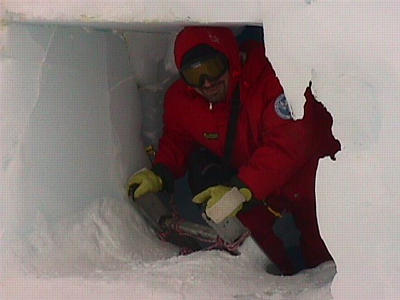
Fabio was just climbing up the ladder that led down into the larger ice cave. I suppose we had to go down ten feet or so to reach the bottom of the cave.
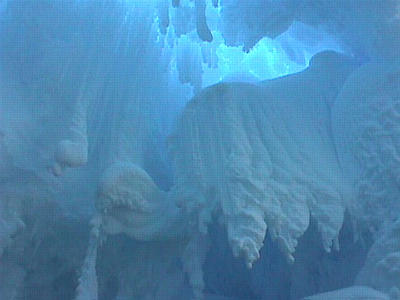
These ice formations were just beautiful! The blue glacier ice was covered with crystals and unusual patterns.
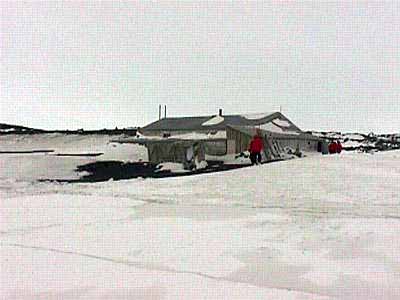
Robert Scott's hut at Cape Evans...for the Terra Nova expedition, 1911. Scott reached the South Pole, but didn't survive the return trip to this hut.
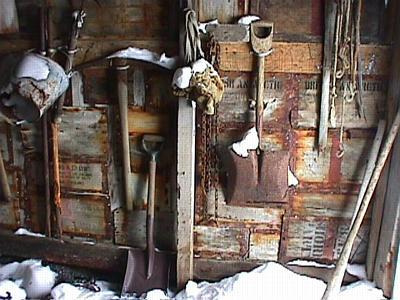
As I stood in the hut, I tried to imagine the men coming to retrieve their tools, and to imagine what it would be like to live in this hut, on the lonliest continent on Earth.
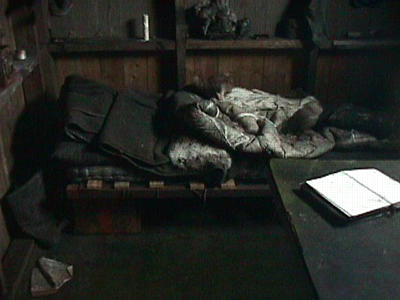
This was Robert Scott's bed...near the back of the hut. The officers had their bunks set apart from the other men.
Contact the TEA in the field at
.
If you cannot connect through your browser, copy the
TEA's e-mail address in the "To:" line of
your favorite e-mail package.
|
